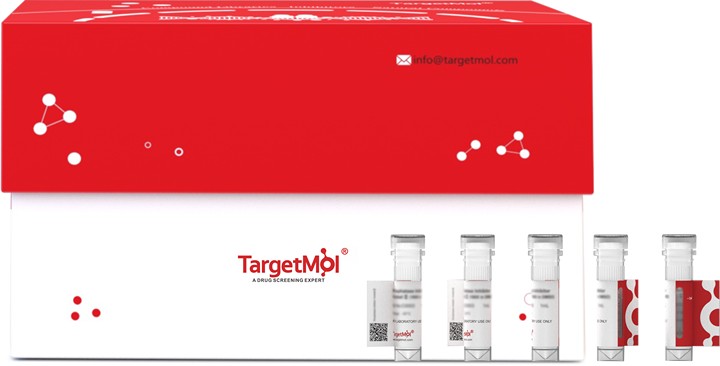 Your shopping cart is currently empty
Your shopping cart is currently empty
Caspase-10 Protein, Human, Recombinant (His)
Caspase-10 (CASP10) is a 521 amino acid protein member of the Cysteine-Aspartic Acid Protease (Caspase) family. CASP10 contains two DED (Death Effector) domains and is detectable in most tissues. CASP10 cleavage by Granzyme B and autocatalytic activity generate the two active subunits: Caspase-10 subunit p23/17, Caspase-10 subunit p12. Caspases are a family of cytosolic aspartate-specific cysteine proteases involved in the execution-phase of cell apoptosis, the initiation and execution. Human caspases can be subdivided into three functional groups: cytokine activation (caspase-1, -4, -5, and -13), apoptosis initiation (caspase-2, -8, -9, -and -10), and apoptosis execution (caspase-3, -6, and -7). CASP10 cleaves and activates caspases 3 and 7, but itself is processed by caspase 8. Defects in CASP10 are associated with apoptosis defects seen in type II autoimmune lymphoproliferative syndrome.

Caspase-10 Protein, Human, Recombinant (His)
| Pack Size | Price | USA Warehouse | Global Warehouse | Quantity |
|---|---|---|---|---|
| 5 μg | $112 | 7-10 days | 7-10 days | |
| 10 μg | $183 | 7-10 days | 7-10 days | |
| 20 μg | $292 | 7-10 days | 7-10 days | |
| 50 μg | $545 | 7-10 days | 7-10 days | |
| 100 μg | $813 | 7-10 days | 7-10 days | |
| 200 μg | $1,190 | 7-10 days | 7-10 days | |
| 500 μg | $2,070 | 7-10 days | 7-10 days | |
| 1 mg | $2,970 | 7-10 days | 7-10 days |
Product Information
| Biological Activity | Activity has not been tested. It is theoretically active, but we cannot guarantee it. If you require protein activity, we recommend choosing the eukaryotic expression version first. |
| Description | Caspase-10 (CASP10) is a 521 amino acid protein member of the Cysteine-Aspartic Acid Protease (Caspase) family. CASP10 contains two DED (Death Effector) domains and is detectable in most tissues. CASP10 cleavage by Granzyme B and autocatalytic activity generate the two active subunits: Caspase-10 subunit p23/17, Caspase-10 subunit p12. Caspases are a family of cytosolic aspartate-specific cysteine proteases involved in the execution-phase of cell apoptosis, the initiation and execution. Human caspases can be subdivided into three functional groups: cytokine activation (caspase-1, -4, -5, and -13), apoptosis initiation (caspase-2, -8, -9, -and -10), and apoptosis execution (caspase-3, -6, and -7). CASP10 cleaves and activates caspases 3 and 7, but itself is processed by caspase 8. Defects in CASP10 are associated with apoptosis defects seen in type II autoimmune lymphoproliferative syndrome. |
| Species | Human |
| Expression System | E. coli |
| Tag | C-6xHis |
| Accession Number | Q92851-4 |
| Synonyms | MCH4,ICE-Like Apoptotic Protease 4,FLICE2,FAS-Associated Death Domain Protein Interleukin-1B-Converting Enzyme 2,Caspase-10,CASP-10,CASP10,Apoptotic Protease Mch-4 |
| Amino Acid | Val220-Ile480 |
| Construction | Val220-Ile480 |
| Protein Purity | Greater than 70% as determined by reducing SDS-PAGE. (QC verified) |
| Molecular Weight | 33 KDa (reducing condition) |
| Endotoxin | < 1 EU/μg by the LAL method. |
| Formulation | Supplied as a 0.2 μm filtered solution of 20 mM Tris-HCl, 8% Sucrose, 1 mM DTT, 0.05% Tween 80, pH8.5. |
| Stability & Storage | Lyophilized powders can be stably stored for over 12 months, while liquid products can be stored for 6-12 months at -80°C. For reconstituted protein solutions, the solution can be stored at -20°C to -80°C for at least 3 months. Please avoid multiple freeze-thaw cycles and store products in aliquots. |
| Shipping | Shipping with blue ice. |
| Research Background | Caspase-10 (CASP10) is a 521 amino acid protein member of the Cysteine-Aspartic Acid Protease (Caspase) family. CASP10 contains two DED (Death Effector) domains and is detectable in most tissues. CASP10 cleavage by Granzyme B and autocatalytic activity generate the two active subunits: Caspase-10 subunit p23/17, Caspase-10 subunit p12. Caspases are a family of cytosolic aspartate-specific cysteine proteases involved in the execution-phase of cell apoptosis, the initiation and execution. Human caspases can be subdivided into three functional groups: cytokine activation (caspase-1, -4, -5, and -13), apoptosis initiation (caspase-2, -8, -9, -and -10), and apoptosis execution (caspase-3, -6, and -7). CASP10 cleaves and activates caspases 3 and 7, but itself is processed by caspase 8. Defects in CASP10 are associated with apoptosis defects seen in type II autoimmune lymphoproliferative syndrome. |
Dose Conversion
Calculator
Tech Support
| Size | Quantity | Unit Price | Amount | Operation |
|---|

Copyright © 2015-2025 TargetMol Chemicals Inc. All Rights Reserved.



